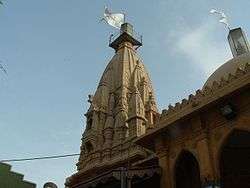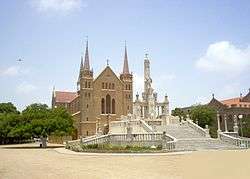Religion in Pakistan
| Part of a series on the |
| Culture of Pakistan |
|---|
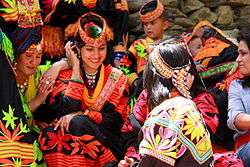 |
| Traditions |
|
Mythology and folklore |
| Cuisine |
|
Music and performing arts |
| Sport |
|
Monuments |
|
.jpg)
The state religion in Pakistan is Islam, which is practiced by about 95–98% of the 195,343,000[2][3] people of the nation.[4][5][6] The remaining 2–5% practice Christianity, Hinduism and other religions.[6][7] Muslims are divided into the following sects: the majority of them practice Sunni Islam, while 10–25% are Shias[8][9][10][11] and 2.2% are Ahmadi Muslims,[12] although the last are not permitted to call themselves Muslim. Nearly all Pakistani Sunni Muslims belong to the Hanafi Fiqh Islamic law school.[6] The majority of Pakistani Shia Muslims belong to the Ithnā‘Ashariyyah Islamic law school, with significant minority groups who practice Ismailism, which is composed of Nizari (Aga Khanis), Mustaali, Dawoodi Bohra, Sulaymani, and others.
Constitutional provisions
The constitution of Pakistan establishes Islam as the state religion,[13] and provides all its citizens the right to profess, practice and propagate their religion subject to law, public order, and morality.[14] The constitution limits the political rights of Pakistan's non-Muslims, and only Muslims are allowed to become the President[15] or the Prime Minister.[16] Moreover, only Muslims are allowed to serve as judges in the Federal Shariat Court, which has the power to strike down any law deemed un-Islamic, though its judgments can be overruled by the Supreme Court of Pakistan.[17]
Demographics of religion in Pakistan
Based on information collected from the Library of Congress, Pew Research Center, CIA World Factbook, Oxford University, University of Pennsylvania, U.S. State Department and others, the following is a list of estimations about the percentage of people professing different faiths in the country. These estimations vary considerably from source to source, depending on methods of research and databases that were used.
- Islam (96.0%)
- Other religions
As of 2012, around 5,900,000 Pakistanis of non-Muslim faiths were holding the Computerised National Identity Card (CNIC cards) from National Database and Registration Authority (NADRA), which can only be obtained by citizens over 18 years of age. It is estimated that some 96% adult Pakistanis currently hold CNIC cards, and therefore the total adult population of non-Muslim religions seems to be over 3 million. Of the minority CNIC holders, 1,414,527 were Hindus (769,647 males and 644,880 females), 1,270,051 were Christians (731,713 males and 538,338 females), 125,681 were Ahmadi Muslims (63,479 males and 62,202 females), 33,734 were Bahais, 6,146 were Sikhs, 4,020 were Parsis, 1,492 were Buddhist and 66,898 were others (such as Kalasha Animists).[24]
Islam
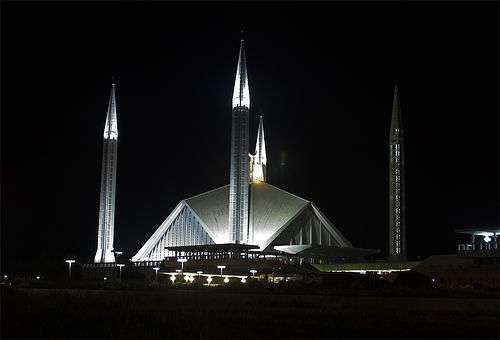
Islam is the state religion of Pakistan, and about 95-98% of Pakistanis are Muslim.[6] The Muslims are largely divided into two sects, Sunni Islam and Shia Islam. The Shia Islam in Pakistan is practiced by 5-20%[4][6][7][18][19][20] of the Muslims and the remaining larger number of Muslims practice Sunni Islam.[4][7][18][19][20] There are a number of Islamic law schools called Madhab (schools of jurisprudence), which are called fiqh or 'Maktab-e-Fikr' in Urdu. Nearly all Pakistani Sunni Muslims belong to the Hanafi Islamic school of thought while small number belong to the Hanbali school. The majority of Pakistani Shia Muslims belong to the Twelver (Ithna Asharia) branch, with significant minority who adhere to Ismailism branch that is composed of Nizari (Aga Khanis), Mustaali, Dawoodi Bohra, Sulaymani, and others. Sufis and above mentioned Sunni and Shia sects are considered to be Muslims according to the Constitution of Pakistan.
Sufi
Islam to some extent syncretized with pre-Islamic influences, resulting in a religion with some traditions distinct from those of the Arab world. Two Sufis whose shrines receive much national attention are Ali Hajweri in Lahore (ca. 11th century) and Shahbaz Qalander in Sehwan, Sindh (ca. 12th century). Sufism, a mystical Islamic tradition, has a long history and a large popular following in Pakistan. Popular Sufi culture is centered on Thursday night gatherings at shrines and annual festivals which feature Sufi music and dance. Contemporary Islamic fundamentalists criticize its popular character, which in their view, does not accurately reflect the teachings and practice of the Prophet and his companions. There have been terrorist attacks directed at Sufi shrines and festivals, 5 in 2010 that killed 64 people.[25][26] Sufism in Pakistan started to lose its role as a powerful influence in the life of the Muslims of Pakistan in the early 1970s. The elections in 1970 gave rise to orthodox Muslim parties that emphasized Sharia and were hostile to heterodox folk Sufi traditions. The mass media and economic migration of Pakistanis to the Middle East exposed to them to the Muslims of other nations. The Islamic text books in schools taught orthodox Islam as opposed to Sufism. The Umrah and Hajj travel to Makkah and Madina became easier and cost effective due to direct air travel. Millions of Pakistanis performed Haj and Umrah the Pakistani Muslim society became more religious. The Muslim television channels also increased the awareness of Sharia and Sufi traditions declined. The Pakistan's Muslim society questioned and opposed the folk and heterodox Sufi traditions. Pakistan witnessed the growth of the Wahhabi movement with many Madrasa and mosques switching to Salafi Islam. The Urs, the death anniversary of a Sufi saint, had turned into yearly fairs over the centuries where entertainment, music, trade and commerce took precedence over religion. The orthodox Muslims violently opposed these practices, termed it as shirk and many incidents violent confrontations took place.[27] Sufism does not play a prominent role in Pakistani society any more. Many hardline Muslims and political movements are not in favor of it in Pakistan.[28] Many traditions of Sufism are now considered to be haram or forbidden in Islam.[29] The Urs of Sufi saint in Karachi, Abdullah Shah Ghazi and Pir Mangho Urs has seen steady decline of attendance over the years.
Ahmadiyya
The Ahmadiyya Muslim community, a minority group is also present. In 1974, the government of Pakistan amended the Constitution of Pakistan to define a Muslim "as a person who believes in finality of Prophet Muhammad".[30] Ahmadis believe in Muhammad as the best and the last law bearing prophet and Mirza Ghulam Ahmad as the Messiah of Muslims. Consequently, they were declared non-Muslims by a parliamentary tribunal. According to the last Pakistan census, Ahmadi Muslims made 0.25% of the population, however, the Ahmadiyya Muslim Community boycotted the census. Independent groups generally estimate the population to be somewhere between 2 and 5 million Ahmadi Muslims. In media reports, 4 million is the most commonly cited figure.[12]
Hinduism
Hinduism is the second largest religion in Pakistan accounting for 2% of the population. The Rig Veda, the oldest Hindu text was believed to have been composed in the Punjab province of modern-day Pakistan on the banks of Indus River around 1500 BCE[31] and spread from there across South and South East Asia slowly developing and evolving into the various forms of the faith we see today. Although no population census recording religious affiliation has taken place since 1998, if the numbers are extrapolated then Hindus would account for around 3 to 3.5 million people today. According to the last census held in 1998, 93% of Hindus live in Sindh, 5% in Punjab and nearly 2% in Balochistan.[21]
Christianity
Christians (Urdu: مسيحى) make up 1.6% of Pakistan's population, about 2.8 million people out of a total population.[4] The majority of the Pakistani Christian communities is constituted by converts from the Hindus, Sikhs, and Muslims from Punjab region, from the British colonial era. The community is geographically spread throughout the Punjab province, whilst its presence in the rest of the provinces is mostly confined to the urban centers. There is a Roman Catholic community in Karachi which was established by Goan and Tamil migrants when Karachi's infrastructure was being developed by the British during colonial administration between World War I and World War II.
Meanwhile, there are few Protestant groups conducting missions in Pakistan. The Day by Day Christian Ministries which is based in the Philippines is operating a school in Karachi, though most of its members there converted outside the country due to restrictions at home.
Bahá'í
The Bahá'í Faith in Pakistan begins previous to its independence when it was still under British colonial rule. The roots of the religion in the region go back to the first days of the Bábí religion in 1844,[32] with Shaykh Sa'id Hindi who was from Multan.[33] During Bahá'u'lláh's lifetime, as founder of the religion, he encouraged some of his followers to move to the area that is current-day Pakistan.[34]
The Bahá'ís in Pakistan have the right to hold public meetings, establish academic centers, teach their faith, and elect their administrative councils.[35] However, the government prohibits Bahá'ís, as well as every other citizen, from travelling to Israel for Bahá'í pilgrimage.[36] Recent estimates are over 79,000[22] though Bahá'ís claimed less than half that number.[37]
Sikhism
In the 17th century the reformist Sikh movement originated in Pakistan's Punjab region where Sikhism's founder as well as most of the faiths disciples originated from. There are a number of Sikhs living throughout Pakistan today; estimates vary, but the number is thought to be on the order of 20,000. In recent years, there numbers have increased with many Sikhs migrating from neighboring Afghanistan who have joined their co-religionists in Pakistan.[20] The shrine of Guru Nanak Dev is located in Nankana Sahib near the city of Lahore where many Sikhs from all over the world make pilgrimage to this and other shrines.
Zoroastrianism
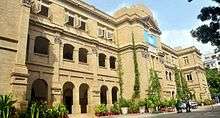
There are at least 4,000 Pakistani citizen practicing the Zoroastrian religion.[38] With the flight of Zoroastrians from Greater Iran into the Subcontinent, the Parsi communities were established. More recently, from the 15th century onwards, Zorastrians came to settle the coast of Sindh and have established thriving communities and commercial enterprises. These newer migrants were to be called Parsi. At the time of independence of Pakistan in 1947, Karachi and Lahore were home to a thriving Parsi business community. Karachi had the most prominent population of Parsis in Pakistan. After independence, many migrated abroad but a number remained. Parsis have entered Pakistani public life as social workers, business folk, journalists and diplomats. The most prominent Parsis of Pakistan today include Ardeshir Cowasjee, Byram Dinshawji Avari, Jamsheed Marker, as well as the late Minocher Bhandara. The founding father of Pakistan, Muhammad Ali Jinnah, married Ratti Bai who belonged to a Parsi family before her conversion to Islam.[39]
Kalash
This is pagan religion of the Kalash people living in a remote part of Chitral. Adherents of the Kalash religion number around 3,000 and inhabit three remote valleys in Chitral; Bumboret, Rumbur and Birir. Their religion is unique but shares some common ground with Greek, Macedonian Pagan, Vedic and Pre-Zoroastrian religions.
Jainism
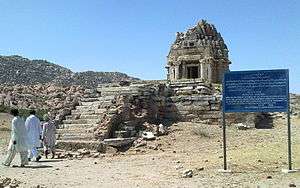
Jainism existed in Sindh, Punjab, Balochistan, Khyber Pakhtunkhwa and Karachi, before the partition in 1947, and even for several years after the partition. There is no evidence of any Jains living in Pakistan today, although it is claimed that a few still live in Sindh and Punjab provinces. They are number of disused Jain Temples found in different parts of Pakistan. Gulu Lalvani, a famous Jain, was originally from Pakistan but he, like other Jains, emigrated from Pakistan. Baba Dharam Das Tomb is also found in Pakistan. The Jain temple temple at Gori in Tharparkar was a major Jain pilgrimage center. The Jain Mandir Chowk at Lahore was the site of a Digambar Jain Temple. The memorial of Jain seer Vijayanandsuri at Gujranwala is now a police station.
Buddhism
Buddhism has an ancient history in Pakistan; currently there is a small community of at least 1500 Pakistani Buddhist in the country.[38] The country is dotted with numerous ancient and disused Buddhist stupas along the entire breath of the Indus River that courses through the heart of the country. Many Buddhist empires and city states existed, notably in Gandhara but also elsewhere in Taxila, Punjab and Sindh. It is believed that Tantric Buddhism was developed in Pakistan's Swat valley. Pakistan and much of Afghanistan were one of the first regions to adopt Buddhism and which saw a large number of adherents to the faith. It is believed that through the Silk Road of northern Pakistan, that Buddhism spread later to Central Asia, China and beyond.
Judaism
Various estimates suggest that there were about 1,500 Jews living in Pakistan at the time of its independence on 14 August 1947, with the majority living in Karachi and a few living in Peshawar. However, almost all emigrated to Israel after 1948. There are a few disused synagogues in both cities; while one Karachi synagogue was torn down for the construction of a shopping mall. The one in Peshawar still exists, although the building is not being used for any religious purpose. There is a small Jewish community of Pakistani origin settled in Ramla, Israel.
One Pakistani, Fishel Benkhald of Karachi calls himself Pakistan's only Jew. His mother is Jewish (making him Jewish by Jewish custom) but, because his father is a Muslim, Pakistani authorities refuse to recognize him as Jewish.[40][41]
Irreligion
There are people who do not profess any faith (such as atheists and agnostics) in Pakistan but their numbers is not known.[42] They are particularly in the affluent areas of the larger cities. Some were born in secular families while others in religious ones. According to the 1998 census, people who did not state their religion accounted for 0.5% of the population, but social pressures against claiming no religion was strong.[20] A 2012 study by Gallup Pakistan found that people not adhering to any religion account for 1% of the population.[43]
In September 2010 a Facebook group surfaced for [ www.aaapakistan.org/ Atheist & Agnostic Alliance Pakistan].[44] On August 2011, they launched their website www.aaapakistan.org which received more than 17,000 hits in just 48 hours after its launch from 95 countries.[42] The AAAP wants a non-theist box to be added on the passport and to be easier for Pakistanis to change their religion legally if they want.[42]
See also
- Blasphemy law in Pakistan
- Demographics of Pakistan
- Minorities in Pakistan
- Freedom of religion in Pakistan
References
- ↑ "South Asia ::PAKISTAN". CIA The World Factbook.
- ↑ 2014 World Population Data
- ↑ Information on other countries: http://hdr.undp.org/en/media/HDR_20072008_EN_Complete.pdf
- 1 2 3 4 5 "Country Profile: Pakistan" (PDF). Library of Congress Country Studies on Pakistan. Library of Congress. February 2005. Retrieved 2010-09-01.
Religion: The overwhelming majority of the population (96.3 percent) is Muslim, of whom approximately 95 percent are Sunni and 5 percent Shia.
- ↑ "Population: 174,578,558 (July 2010 est.)". Central Intelligence Agency. The World Factbook on Pakistan. Retrieved 2010-08-28.
- 1 2 3 4 5 "Pakistan, Islam in". Oxford Centre for Islamic Studies. Oxford University Press. Retrieved 2010-08-29.
Approximately 97 percent of Pakistanis are Muslim. The majority are Sunnis following the Hanafi school of Islamic law. Between 10–15 percent are Shiis, mostly Twelvers.
- 1 2 3 4 "Religions: Muslim 95% (Sunni 75%, Shia 20%), other". Pakistan (includes Christian and Hindu) 5%. The World Factbook. CIA. 2010. Retrieved 2010-08-28.
- 1 2 "Shia Muslims Population".
Pakistan has Shia population of 10–25%.
- 1 2 http://shianumbers.com/shia-muslims-population.html
- 1 2 "Field Listing : Religions". The World Factbook. Central Intelligence Agency. 2010. Retrieved 24 August 2010.
- 1 2 "Chapter 1: Religious Affiliation". The World's Muslims: Unity and Diversity. Pew Research Center's Religion & Public Life Project. August 9, 2012. Retrieved 26 June 2015.
- 1 2 3 The 1998 Pakistani census states that there are 291,000 (0.22%) Ahmadis in Pakistan. However, the Ahmadiyya Muslim Community has boycotted the census since 1974 which renders official Pakistani figures to be inaccurate. Independent groups have estimated the Pakistani Ahmadiyya population to be somewhere between 2 million and 5 million Ahmadis. However, the 4 million figure is the most quoted figure and is approximately 2.2% of the country. See:
- over 2 million: Immigration and Refugee Board of Canada (2008-12-04). "Pakistan: The situation of Ahmadis, including legal status and political, education and employment rights; societal attitudes toward Ahmadis (2006 - Nov. 2008)". Retrieved 2012-06-28.
- 3 million: International Federation for Human Rights: International Fact-Finding Mission. Freedoms of Expression, of Association and of Assembly in Pakistan. Ausgabe 408/2, Januar 2005, S. 61 (PDF)
- 3–4 million: Commission on International Religious Freedom: Annual Report of the United States Commission on International Religious Freedom. 2005, S. 130
- 4.910.000: James Minahan: Encyclopedia of the stateless nations. Ethnic and national groups around the world. Greenwood Press . Westport 2002, page 52
- "Pakistan: Situation of members of the Lahori Ahmadiyya Movement in Pakistan". Retrieved April 30, 2014.
- ↑ "The Constitution of Pakistan, Part I: Introductory". Pakistani.org. Retrieved 2013-06-19.
- ↑ "The Constitution of Pakistan, Part II: Chapter 1: Fundamental Rights". Pakistani.org. Retrieved 2013-06-19.
- ↑ "The Constitution of Pakistan, Part III: Chapter 1: The President". Pakistani.org. Retrieved 2013-06-19.
- ↑ The Constitution of Pakistan, Notes for Part III, Chapter 3 Archived November 10, 2009, at the Wayback Machine.
- ↑ "The Constitution of Pakistan, Part VII: Chapter 3A: Federal Shariat Court". Pakistani.org. Retrieved 2013-06-19.
- 1 2 3 "Mapping the Global Muslim Population: A Report on the Size and Distribution of the World's Muslim Population". Pew Research Center. October 7, 2009. Retrieved 2010-08-28.
- 1 2 3 Miller, Tracy, ed. (October 2009). Mapping the Global Muslim Population: A Report on the Size and Distribution of the World's Muslim Population (PDF). Pew Research Center. Retrieved 2010-08-28.
- 1 2 3 4 5 6 "Pakistan - International Religious Freedom Report 2008". United States Department of State. Retrieved 2010-08-28.
- 1 2 3 "Population by religion". Archived from the original on 2 April 2014.
- 1 2 "Most Baha'i Nations (2005)". QuickLists > Compare Nations > Religions >. The Association of Religion Data Archives. 2005. Retrieved 2009-07-04.
- ↑ "Being Cyrus in Karachi | Pakistan Today | Latest news | Breaking news | Pakistan News | World news | Business | Sport and Multimedia". Pakistan Today. Retrieved 2013-06-19.
- ↑ Ghauri, Irfan. "Over 35,000 Buddhists, Baha'is call Pakistan home – The Express Tribune". Tribune.com.pk. Retrieved 2013-06-19.
- ↑ Produced by Charlotte Buchen. "Sufism Under Attack in Pakistan" (video). The New York Times. Retrieved May 21, 2012.
- ↑ Huma Imtiaz; Charlotte Buchen (January 6, 2011). "The Islam That Hard-Liners Hate" (blog). The New York Times. Retrieved May 21, 2012.
- ↑ Sufism threatened
- ↑ Diminishing Returns: Sufi Shrines in Pakistan's Politics
- ↑ Mystical Islam 'under threat' in Pakistan
- ↑ "The Holy Prophet Muhammad (saw)". Ahmadiyya Muslim Community. Retrieved 2009-07-29.
- ↑ http://www.britannica.com/EBchecked/topic/503627/Rigveda
- ↑ "The Bahá'í Faith -Brief History". Official Website of the National Spiritual Assembly of India. National Spiritual Assembly of the Bahá'ís of India. 2003. Retrieved 2009-04-04.
- ↑ "History of the Bahá'í Faith in Pakistan". Official Webpage of the National Spiritual Assembly of the Bahá'ís of Pakistan. National Spiritual Assembly of the Bahá'ís of Pakistan. 2008. Retrieved 2009-04-12.
- ↑ Momen, Moojan; Smith, Peter. "Bahá'í History". Draft A Short Encyclopedia of the Baha'i Faith. Bahá'í Library Online. Retrieved 2009-04-04.
- ↑ Wardany, Youssef (2009). "The Right of Belief in Egypt: Case study of Baha'i minority". Al Waref Institute. Retrieved 2009-04-04.
- ↑ "Top 20 Largest National Baha'i Populations". Adherents.com. Adherents.com. 2008. Retrieved 2008-11-18.
- ↑ compiled by Wagner, Ralph D. "Pakistan". Synopsis of References to the Bahá'í Faith, in the US State Department's Reports on Human Rights 1991-2000. Bahá'í Academics Resource Library. Retrieved 2009-04-12.
- 1 2 Ghauri, Irfan. "Over 35,000 Buddhists, Baha'is call Pakistan home, By Irfan Ghauri Published: September 2, 2012, Dawn". Tribune.com.pk. Retrieved 2013-06-19.
- ↑ "Quaid i Azam Muhammad Ali Jinnah: Early days". Government of Pakistan. Archived from the original on 24 October 2008.
- ↑ Pakistan's last Jew in battle to win 'empathy', Simon Caldwell, November 26, 2015
- ↑ 'Last Jew in Pakistan' beaten by mob, arrested, Express Tribune, March 6, 2015
- 1 2 3 "Being Pakistani and atheist a dangerous combo, but some ready to brave it | Pakistan Today | Latest news | Breaking news | Pakistan News | World news | Business | Sport and Multimedia". Pakistan Today. 2011-09-17. Retrieved 2013-06-19.
- ↑ http://www.gallup.com.pk/Polls/240712.pdf
- ↑ "Pakistani Muslim youths turning into atheists". Ibnlive.in.com. 2010-09-06. Retrieved 2013-06-19.

